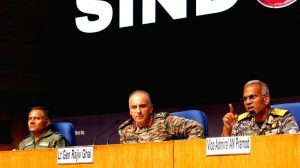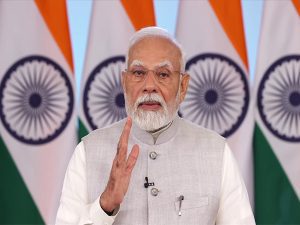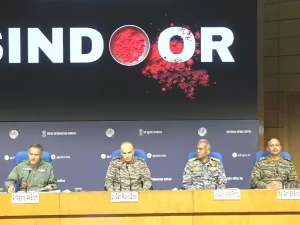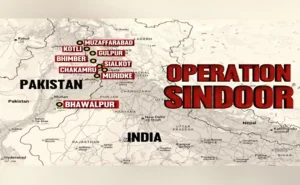New Delhi – The recent Operation Sindoor Press Conference unveiled India’s decisive shift in addressing cross-border terrorism. On Sunday, top military brass including Air Marshal AK Bharti, DGMO Lieutenant General Rajiv Ghai, and Vice Admiral AN Pramod provided a comprehensive briefing on the operation. The Operation Sindoor Press Conference articulated how India has set a “new normal” in dealing with terrorism emanating from Pakistan, emphasizing that the operation is still ongoing.
Senior officials at the Operation Sindoor Press Conference explained that India’s response was both ferocious and proportionate, forcing Pakistan to reconsider its approach. The military action had clear objectives spanning military, political, and psychological domains, making it evident to both Pakistan and international interlocutors that supporting terrorism would now carry significant costs.
Setting A “New Normal” In Bilateral Relations

“The actions taken by India are aimed at creating and setting a new normal in the relationship. It is not business as usual,” a senior official stated during the Operation Sindoor Press Conference. This statement underscores the strategic shift in India’s approach, moving away from measured restraint to proactive deterrence.
The Operation Sindoor Press Conference highlighted that Pakistan and the international community would need to adapt to this new paradigm, as India has reached its threshold of tolerance. This development follows the understanding reached between the two countries on halting military actions after four days of escalating conflict involving sophisticated weaponry.
Also Read: PM Modi On Ceasefire Violation: Powerful Response To Pakistan’s Border Provocations
Swift Military Action With Clear Communication
During the Operation Sindoor Press Conference, officials revealed previously unknown details about the operation’s execution. Within just 15 minutes of concluding the first set of military strikes on terrorist infrastructure at nine locations in Pakistan and Pakistan-Occupied Kashmir between 1:04 am and 1:30 am on May 7, India’s Director General of Military Operations informed his Pakistani counterpart that the attacks targeted only terror groups, and India remained open to dialogue.
The Operation Sindoor Press Conference disclosed that when Pakistan did not respond constructively, Prime Minister Narendra Modi issued unambiguous instructions to the armed forces: India’s retaliation to any Pakistani military action should be “bigger and stronger.” A source quoted the Prime Minister as saying, “Wahan se goli chalegi, toh yahan se gola chalega” (If they fire bullets, we will respond with cannons).


Multiple Objectives Achieved
Military leaders at the Operation Sindoor Press Conference confirmed that India achieved its primary military objective within 30 minutes of launching strikes on May 7, successfully destroying targeted terrorist infrastructure. The political objective of raising the cost of supporting cross-border terrorism was also accomplished.

The Operation Sindoor Press Conference revealed India’s strategy of striking terrorists deep within Pakistan territory, not merely at border areas. “The terrorists were struck in the heartland of Pakistan, not at the border,” a senior military official explained, confirming that India had fulfilled its commitment to target terrorists in their strongholds.
Raising The Cost Of Terrorism
A significant revelation from the Operation Sindoor Press Conference was the link between terrorism and bilateral cooperation. Officials stated that the Indus Waters Treaty, which has survived three wars and decades of cross-border terrorism, would be held in abeyance as long as terrorism from Pakistan continues.
The Operation Sindoor Press Conference made it clear that costs for Pakistan’s support of terrorism would increase proportionately with each terrorist act. While terrorism may not end immediately following these strikes, India has committed to responding to every act of terrorism. Officials emphasized that neither the Line of Control, the international border, nor Pakistan’s nuclear capabilities would protect terrorists.
Distinguishing Features Of Operation Sindoor
Military experts participating in the Operation Sindoor Press Conference explained what set this operation apart from previous counter-terrorism responses like the surgical strikes after the 2016 Uri attack and the air strike on Balakot following the 2019 Pulwama bombing.
The Operation Sindoor Press Conference detailed the escalation pattern that followed India’s initial strikes on May 7. Pakistan attacked Indian military bases on May 8, 9, and 10, triggering progressively stronger responses from India. These counter-strikes targeted Pakistani military facilities including air defense systems, radar sites, and command and control centers.
Pakistan’s Attacks And India’s Response
According to information shared at the Operation Sindoor Press Conference, Pakistan launched its “most ambitious and wide-ranging attacks” on May 10, attempting to strike 26 Indian military locations with heavier caliber weapons. Despite India repeatedly expressing its intention not to escalate, these provocations led to a more forceful response.
The Operation Sindoor Press Conference revealed that India decided to significantly raise the military cost for Pakistan, responding with “hellfire” by striking eight of Pakistan’s main airbases, including Chaklala, Rafiqui, Murid, Rahim Yar Khan, Chunian, and Sialkot, using precision weapons. Military officials confirmed extensive damage, with the runway at Rahim Yar Khan airbase being particularly devastated.
Ceasefire On India’s Terms
Military leadership at the Operation Sindoor Press Conference emphasized that the ceasefire agreement was reached on India’s terms and wasn’t forced upon New Delhi. After four days of intense confrontations, the DGMOs of both nations reached an understanding on Saturday afternoon.
The Operation Sindoor Press Conference pointed out that Pakistan’s decision to halt hostilities wasn’t primarily due to international pressure but resulted from the effectiveness of India’s military response. “The Pakistanis stopped because things were falling down on them from the sky. And making a very loud noise,” a senior official remarked.
Strategic Target Selection And Psychological Impact


Details provided during the Operation Sindoor Press Conference explained the rationale behind India’s selection of nine locations in Pakistan and Pakistan-occupied Kashmir for strikes. Targets included Jaish-e-Mohammed’s main base at Bahawalpur, Lashkar-e-Taiba’s stronghold at Muridke (both in Pakistan’s Punjab province), and bases of groups like Harkat-ul-Mujahideen and Harkat-ul-Ansar in Muzaffarabad.
The Operation Sindoor Press Conference emphasized that these facilities share deep connections with Pakistan’s state apparatus and have long histories of terrorist activities against India. Officials noted that the JeM base at Bahawalpur was among the first targets struck on May 7, hit with the “most potent weapon available,” highlighting JeM founder Masood Azhar’s links to numerous attacks in India.
Evidence Of State-Terrorism Links
In concluding the Operation Sindoor Press Conference, officials presented evidence that emerged following the attack on Muridke, showing senior Pakistani military and civilian officials attending funerals of those killed at the LeT base near Lahore. This evidence further solidified the connection between terrorist organizations and Pakistan’s official establishments.
“The funeral of terrorists being conducted with coffins wrapped in flags and military officers present should put to rest the myth that the terrorists are only linked with Pakistan’s intelligence agencies,” stated a senior official at the Operation Sindoor Press Conference, noting the presence of Lahore’s deputy commissioner and representation from the Punjab chief minister’s office at these ceremonies.

